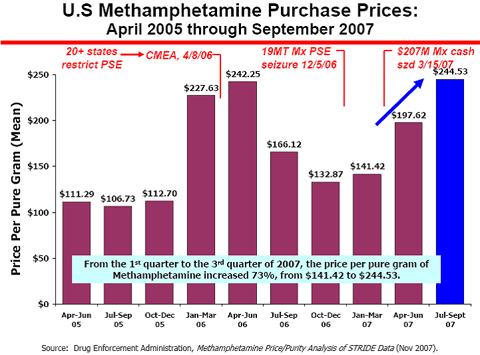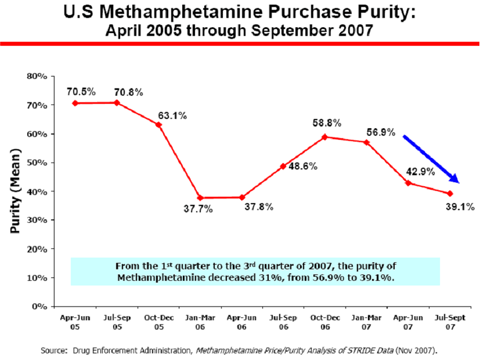Press Release |

|
| PRESS RELEASE November 8, 2007 |
Contact: Jennifer de Vallance |
NEW DATA SHOW SIGNIFICANT DISRUPTIONS IN U.S. METHAMPHETAMINE, COCAINE MARKETS
PRICE OF METH SOARS 73 PERCENT;
PURITY DOWN BY NEARLY A THIRD
(Washington, D.C.)—Today, the U.S. Drug Czar, John Walters, released new data signaling significant progress against methamphetamine. According to the Drug Enforcement Administration's (DEA) System to Retrieve Information on Drug Evidence (STRIDE) database, the average price per pure gram of methamphetamine increased 73 percent from January 2007 through September of this year, from $141.42 to $244.53. During the same period, the purity of meth dropped 31 percent.
Director Walters credited State and local law enforcement officials, as well as the Mexican government, with much of the progress. “The intense pressure placed on meth producers and traffickers has significantly disrupted the market for this devastating drug. New disruptions in the supply of meth are a result of the collective efforts of thousands of individuals here in the U.S. and in Mexico . But it is not time to declare victory; it is time to bolster gains against the supply of meth with further progress against demand. Meth is still on the streets in too many communities, ruining too many lives. The continued pursuit of a balanced strategy, here at home and in cooperation with our international partners, will help us sustain and extend our progress.”
More than 40 States have enacted restrictions on the retail distribution of products containing pseudoephedrine, a key ingredient in the production of methamphetamine. In 2006, President Bush signed the Combat Methamphetamine Epidemic Act into law, supporting existing State efforts and setting a national standard for retail distribution of products containing precursor chemicals. These controls contributed to a dramatic 42 percent drop in the number of domestic meth lab incidents. Mexican drug trafficking organizations soon sought to fill the supply void created by these domestic U.S. controls, and began exporting finished meth into the United States.
Under the leadership of President Felipe Calderon, Mexico has initiated unprecedented controls in the supply of pseudoephedrine. Effective January 2008, Mexico will no longer allow the importation of pseudoephedrine and ephedrine, and all use of the precursor chemicals will be banned throughout the nation by January of 2009 – further reducing the ability of methamphetamine manufacturers to produce and traffic the drug into the United States. Additionally, President Calderon has overseen an aggressive crackdown on drug traffickers and drug-related violence, particularly along the U.S.–Mexico border. More than 12,000 Mexican troops have participated in enforcement operations.
“Increasing purchase prices for cocaine and methamphetamine in the U.S. market and decreasing purity mean one thing – these drugs are less available on the streets of America,” said DEA Administrator Karen P. Tandy. “Drug kingpins are having a harder time moving illegal drugs and chemicals and pocketing the illicit proceeds because they are up against the full court press of sustained, joint initiatives by a historic three-way partnership among Colombia, Mexico, and the United States. This rock solid, international lineup has disrupted the world's highest level narco-traffickers, made illegal drugs costlier and less pure, forced traffickers into an uncertain reactive mode, and formed the linchpin to greater stability throughout the Western Hemisphere.”
While youth meth use has decreased by 50 percent since 2001, the Bush Administration is continuing efforts to drive down the demand for methamphetamine. The National Youth Anti-Drug Media Campaign launched a $10 million public awareness campaign in September, which includes television, print, radio, and Web advertising. An additional advertising effort targeted to American Indian and Alaska Native communities will launch later this month.
Director Walters joined DEA Administrator Karen Tandy, Mexican Attorney General Eduardo Medina Mora Icaza, and Colombian Minister of Defense Juan Manuel Santos in Bogota, Colombia, to release the new STRIDE data, which also support reports of regional U.S. cocaine shortages. From January 2007 through September 2007, there was a 44 percent increase in the average price per pure gram of cocaine in the United States (from $95.35 to $136.93) and a corresponding 15 percent decrease in cocaine purity in the illegal drug market in the United States. These findings support earlier indicators of reductions in cocaine availability in 37 U.S. cities, based on law enforcement intelligence reports and unprecedented reductions in the number of employees testing positive for cocaine in workplace drug tests.
STRIDE is a forensic inventory of evidence acquired by the DEA. It is widely considered a real-time authority of drug intelligence and market trends.

<Click here for larger image>

<Click here for larger image>




